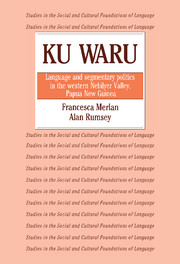Book contents
- Frontmatter
- Contents
- List of illustrations
- List of tables
- List of abbreviations
- Preface and acknowledgments
- 1 Introduction
- 2 The setting
- 3 Some aspects of Ku Waru segmentary sociality
- 4 Ceremonial exchange and marriage in the western Nebilyer Valley
- 5 Some linguistic structures of segmentary politics
- 6 Warfare compensation payment to Laulku: an analysis
- 7 Compensation at Palimung and the Kulka women's club
- 8 The events in perspective
- 9 Perspectives on ‘event’
- Appendix A Transcript of proceedings at Kailge on July 24, 1983
- Appendix B Grammatical sketch of Bo Ung, Ku Waru dialect
- Appendix C The conduct of warfare
- Appendix D Ku Waru metalinguistic expressions
- Chapter notes
- Glossary
- References
- Index
- Plate section
Preface and acknowledgments
Published online by Cambridge University Press: 30 December 2009
- Frontmatter
- Contents
- List of illustrations
- List of tables
- List of abbreviations
- Preface and acknowledgments
- 1 Introduction
- 2 The setting
- 3 Some aspects of Ku Waru segmentary sociality
- 4 Ceremonial exchange and marriage in the western Nebilyer Valley
- 5 Some linguistic structures of segmentary politics
- 6 Warfare compensation payment to Laulku: an analysis
- 7 Compensation at Palimung and the Kulka women's club
- 8 The events in perspective
- 9 Perspectives on ‘event’
- Appendix A Transcript of proceedings at Kailge on July 24, 1983
- Appendix B Grammatical sketch of Bo Ung, Ku Waru dialect
- Appendix C The conduct of warfare
- Appendix D Ku Waru metalinguistic expressions
- Chapter notes
- Glossary
- References
- Index
- Plate section
Summary
This book presents an extended, ethnographically-based argument concerning the relationship between social structures and action, focusing upon speech as a salient aspect of the latter. Evidence for our argument is drawn from seventeen months of fieldwork which we conducted jointly between June 1981 and November 1983 in the Nebilyer Valley, Western Highlands Province of Papua New Guinea.
Even before going to New Guinea, we had always felt acutely the lack of successful integration of language-focused studies into mainstream ethnography. We sensed that this lack was due, not to the irrelevance of such material to ethnographic description and social theory, but to the much more fundamental problem of treating situated social action (including speech) as an object of ethnographic description and analysis. Our field time in the Nebilyer Valley not only strengthened our general conviction that there is a need to develop analyses of social action (integrating its linguistic and other aspects), but also provided us the opportunity to be present at many kinds of events which seemed to demand analysis in terms which could better reveal the relationship between structures and action. This volume is our attempt to provide such an analysis.
The research on which the book is based was undertaken during a first, exploratory trip during June to August, 1981, and then for 14 months between 1981 and the end of 1983. Two interruptions were necessitated by our involvement in Aboriginal land claims in Australia. These rapid transitions from the New Guinea Highlands to Aboriginal Australia and back were unsettling, but also had the positive effect of making differences between the two situations stand out in even greater relief than they otherwise might have.
- Type
- Chapter
- Information
- Ku WaruLanguage and Segmentary Politics in the Western Nebilyer Valley, Papua New Guinea, pp. xii - xviiiPublisher: Cambridge University PressPrint publication year: 1991

